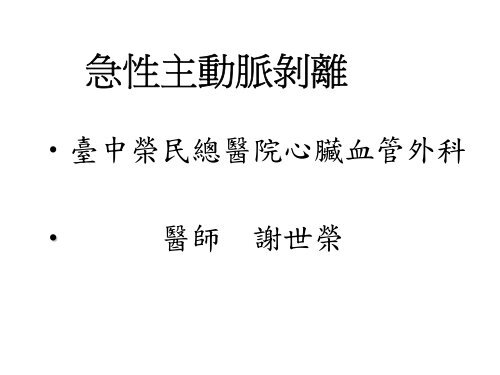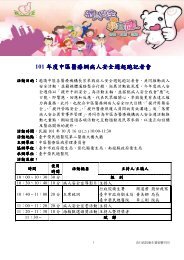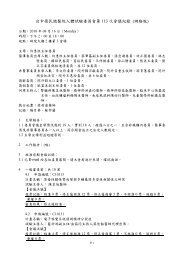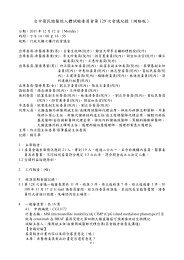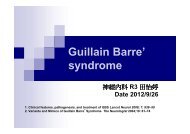Acute aortic dissection - å°ä¸æ¦®æ°ç¸½é«é¢
Acute aortic dissection - å°ä¸æ¦®æ°ç¸½é«é¢
Acute aortic dissection - å°ä¸æ¦®æ°ç¸½é«é¢
You also want an ePaper? Increase the reach of your titles
YUMPU automatically turns print PDFs into web optimized ePapers that Google loves.
我 為 什 麼 反 對using antegrade cerebral perfusionduring operation for patient withacute type A <strong>aortic</strong> <strong>dissection</strong>
Surgical outcome for acute type A <strong>aortic</strong> <strong>dissection</strong>Series Year Number of PatientsAdjuncts (%) Results (%)Preoperative Shock MortalityBakhtiary et al.[97]2008 120 ACP (100) 34 5Knipp et al.[98] (NIS)2007 3013 NA NA 26Rampoldi et al.[75] (IRAD)2007 682 HCA (92) RCP (51) 31 24Apaydin et al.[99]2002 108 HCA (99) 12 25Mehta et al.[100]2002 437 HCA (87) RCP (56) 28 26Bavaria et al.[95]2001 104 HCA(100) RCP (100) 10 9.
主 動 脈 壁 的 三 層 構 造• Intima• Media 中 層內 層中 層 ( 厚 有 彈 性 )• adventitia 外 層 ( 堅 韌 )
主 動 脈 剝 離
The first report of <strong>aortic</strong> <strong>dissection</strong>and the concept of a true and a falselumen are attributed to Shekelton inthe early 1800sThe term anurysme dissequant, ordissecting aneurysm, introduced byLaennec in 1819
Aortic <strong>dissection</strong>• Aortic <strong>dissection</strong> is bestdefined as a splitting ofthe <strong>aortic</strong> turnia mediawith extraluminal blood inthe <strong>aortic</strong> wall.• 主 動 脈 剝 離 的 定 義• 血 液 流 入 主 動 脈 壁 中 層造 成 動 脈 壁 中 層 裂 開 分 離
Aortic Dissection主 動 脈 剝 離• True lumen真 腔• False lumen 假 腔• Septum 中 隔
• <strong>Acute</strong> on chronic <strong>dissection</strong> ---rere-<strong>dissection</strong>• 再 度 ( 貳 次 ) 剝 離• Free rupture and hypovolemic shock• 導 致 主 動 脈 破 裂 , 出 血 死 亡
Dissection results in heart failure近 端 主 動 脈 剝 離容 易 導 致 急 性 心 臟 衰 竭• 1.Tamponade;• 2. <strong>Acute</strong> <strong>aortic</strong> regurgitation;• 3. <strong>Acute</strong> myocardial infarction(compromise coronary arteries)
Malperfusion syndrome
Malperfusion syndromeDissection results in organ failure,CVA, bowel gangrene, limbsischemia (compromise the branches)主 動 脈 剝 離 容 易 導 致 各 器 官 急 性 缺血 性 壞 死 及 功 能 衰 竭 ( 如 中 風 , 心 肌梗 塞 , 腸 壞 死 , 腎 衰 竭 )
CT scan: (for diagnosis of acute<strong>aortic</strong> <strong>dissection</strong>)Noninvasive,Sensitivity of 83% to 95%Specificity of 87% to 100%
<strong>Acute</strong> <strong>aortic</strong> <strong>dissection</strong>發 作 二 週 以 內 稱 為 急 性 主 動 脈 剝 離• In untreated patients, 74% of deathsoccur within this 2-week 2period.• This is the stage when the inflammationis maximal and when the aorta is mostfriable.
Treatment for <strong>Acute</strong> <strong>aortic</strong> <strong>dissection</strong>• Currently, surgical literature, including our ownreported findings, indicates that the site of the<strong>aortic</strong> tear and thrombosis or lack of thrombosisof the false lumen do not influence either early oflate operative results.
Treatment for <strong>Acute</strong> <strong>aortic</strong> <strong>dissection</strong>• Of great importance are the extent of the<strong>aortic</strong> <strong>dissection</strong> and the diameter of theaorta, , because these determine theoperative approach, the extent of resection,and the long-term prognosis, including thelate risk of rupture.
Debakeyclassification of<strong>aortic</strong> <strong>dissection</strong>主 動 脈 剝 離 分 類
Standford classification主 動 脈 剝 離 分 類• Type A :involving the ascending aorta.• Type B :involving all other extents beyondthe left subclavian artery.• It should be noted that <strong>aortic</strong> arch <strong>dissection</strong>swithout involvement of the ascending aortaare now currently classified as type B.
Incidence• Probably 10 per 100,000 of the populationper annum in USA.• 2 deaths per 100,000 males and 0.8 deathper 100,000 males.• This is probably a significant underestimate.• Aortic <strong>dissection</strong> is the most common <strong>aortic</strong>disaster.• 4.2% of all sudden deaths in men wereattributed to <strong>aortic</strong> <strong>dissection</strong>.
Predisposing factors• Hereditary and congenital factors ( 遺 傳 , 先 天 因 子 )• Pregnancy ( 妊 娠 )• Congenital <strong>aortic</strong> valve defects ( 先 天 主 動 脈 瓣 異 常 )• Coarctation of the aorta ( 先 天 主 動 脈 異 常 )• Fusiform <strong>aortic</strong> aneurysm ( 主 動 脈 瘤 )• Inflammatory diseases, infections, and hormonalabnormalities. ( 主 動 脈 發 炎 疾 病 , 內 分 泌 異 常 )
Etiology• Medial degenerative disease. 主 動 脈 壁 中 層 退 化• Hypertension : the higher the dP/dt, , the morerapid the progression of the <strong>dissection</strong>. 高 血 壓• The causes of medial degenerative disease andhypertension remain largely unknown.
Iatrogenic and traumatic factors• Aortic <strong>dissection</strong> can be precipitated byinvasive procedures:• Cardiac catheterization, aortography,arterial and <strong>aortic</strong> cannulation, coronaryartery bypass surgery, <strong>aortic</strong> valvereplacement, intra<strong>aortic</strong> balloon pump, andsimple <strong>aortic</strong> cross-clamping.• 心 導 管 及 心 臟 手 術 可 能 引 起 動 脈 剝 離
<strong>Acute</strong> <strong>aortic</strong> <strong>dissection</strong>• Lam and colleagues performed autopsystudies on 50 patients who died aftercardiac surgery and found that seven(14%) died of <strong>aortic</strong> <strong>dissection</strong>.• 心 臟 手 術 後 死 亡 者 有 14% 是 因 主 動 脈 剝離 引 起
<strong>Acute</strong> proximal <strong>aortic</strong> <strong>dissection</strong> (type A)近 端 主 動 脈 剝 離 應 立 即 開 刀 治 療• Most deaths are caused by rupture of theascending aorta to pericardium and heartfailure.• A patient with acute proximal <strong>dissection</strong>(type A) will undergo immediate repair ofthe ascending aorta, the <strong>aortic</strong> arch, orboth.
<strong>Acute</strong> type A <strong>dissection</strong> 30 days mortality近 端 主 動 脈 剝 離 30 天 死 亡 率• Surgical : 手 術 治 療 mortality 10%-25%.• Medical : 內 科 治 療 mortality morethan 50 % (75%).
<strong>Acute</strong> distal <strong>aortic</strong> <strong>dissection</strong> (type(B) B遠 端 主 動 脈 剝 離 應 先 內 科 治 療• No clinical evident complications medicaltreatment is indicated.• Conditions that may require immediatesurgical treatment : <strong>aortic</strong> rupture,preexisting aneurysm, rapid expansion of<strong>aortic</strong> diameter, ischemia of limbs andvisceral organs, intractable pain,uncontrolled hypertension, progression of<strong>dissection</strong> (becomes type A).
<strong>Acute</strong> type B <strong>dissection</strong> thirty-daymortality遠 端 主 動 脈 剝 離 30 天 死 亡 率• Surgical : 手 術 治 療 20%-25%.• Medical : 內 科 治 療 less than 10 %.
Survival after operation foracute type A <strong>dissection</strong>• 1 month survival rate: 80%.• 1 year survival rate: 66%.• 5 year survival rate: 46%.• 15 year survival rate: 37%• 就 算 第 一 次 手 術 成 功病 人 也 不 會 長 壽
Re-operation for aneurysm after repairof ascending aorta for type A <strong>aortic</strong><strong>dissection</strong>第 一 次 手 術 後 幾 年 內 再 度 開 刀 的 機 會 很高
<strong>Acute</strong> <strong>aortic</strong> <strong>dissection</strong>is the most catastrophic eventaffecting the aorta
The International Registry of <strong>Acute</strong> AorticDissection (IRAD) :began in January 1996. It initially included12 centers in 6 countries and has grown to24 referral centers in 11 countries..
The IRAD study group found an overalloperative mortality of 25% in patientswith proximal <strong>aortic</strong> <strong>dissection</strong> andnoted a significant difference betweenstable patients and those who wereunstable at initial evaluation (17%versus 31%, P < .001). One of the maindeterminants of poor outcome isneurologic status at diagnosis.
Surgical outcome for acute type A <strong>aortic</strong> <strong>dissection</strong>Series Year Number of PatientsAdjuncts (%) Results (%)Preoperative Shock MortalityBakhtiary et al.[97]2008 120 ACP (100) 34 5Knipp et al.[98] (NIS)2007 3013 NA NA 26Rampoldi et al.[75] (IRAD)2007 682 HCA (92) RCP (51) 31 24Apaydin et al.[99]2002 108 HCA (99) 12 25Mehta et al.[100]2002 437 HCA (87) RCP (56) 28 26Bavaria et al.[95]2001 104 HCA(100) RCP (100) 10 9.
Between January 2000 and August 2006, 120consecutive patients underwent repair of acute type A<strong>dissection</strong>. Selective antegrade cerebral perfusionthrough the right subclavian artery combined withmild systemic hypothermia (30 degrees C) was used inall patients.New permanent neurologic deficits : 5 patients(4.2%) TND : 3 patients (2.5%).The 30‐day mortality rate : 5% (n = 6).
Selective antegrade cerebral perfusion
<strong>Acute</strong> type A <strong>aortic</strong> <strong>dissection</strong>Brachiocephalic trunk : was involved in14% of patients,Common carotid arteries : 21%,Left subclavian artery : 14%,Ileofemoral arteries : 35%.Cambria and colleagues were the first toquantify the contribution of saidcomplications to overall mortality. 1988
Review of CT aortogram(all patients with type A <strong>aortic</strong><strong>dissection</strong>)1. 2011-08-05 to 2012-12-012. 40 patients ( out of 50 patients ).3. 31 y/o to 85 y/o; mean 55 y/o.4. Male : Female = 7 : 3 ( 28 : 12 )5. <strong>Acute</strong> <strong>dissection</strong> 32; chronic 8
Operations• Aortic valve resuspension & ascendingaorta replacement : 36.• Aortic root replacement ( modifiedBentall,s operation) & ascending aortareplacement: 4.• Aortic arch reconstruction: 4• Coronary artery bypass grafting ( CABG ):4.
Hospital stay• 7 – 15 days : 23 patients.• Less than 5 days : 4 patients.• More than 30 days : 3 patients
Major complications• Heart failure : 2 (1 myocardial infarction; 1pericardial tamponade).• Pneumonia : 4 (1 Tracheostomy, 85 y/ofemale).• Renal failure (need H/D): 2 .• Ischemic bowel syndrome : 2 .• Biliary tract infection with sepsis: 1.• Spinal cord injury : 1 (partial injury)
Mortality• 30 days mortality rate : 3/40 ( 7.5% ) (4/50 8%)• 30 days mortality rate of chronic type A <strong>aortic</strong><strong>dissection</strong> : 0%• 30 days mortality rate of acute type A <strong>aortic</strong><strong>dissection</strong> : 3/32 (9.4%) (4/40: 10%; 50patients)• In hospital mortality rate of acute type A <strong>aortic</strong><strong>dissection</strong> : 5/40 ( 12.5% )
Major <strong>aortic</strong> branches involved by<strong>dissection</strong> process• Innominate artery: 22 / 40 ( 55% )• Right common carotid artery: 13 / 40 ( 33% )• Left common carotid artery: 9 / 40 ( 23% )• Right subclavian artery : 6 / 40 ( 15% )• Left subclavian artery : 9 / 40 ( 23% ).• Celiac trunk : 21 / 40 ( 53% ).• Superior mesenteric artery : 12 / 40 ( 30% )
Clamping or snaring (by tourniquet) thedissecting artery will result in rupture ofseptum during the acute stage of <strong>dissection</strong>.That will result in arterial dynamic obstructionor intraluminal thrombosis formation
Patient who is potentially suitablefor selective antegrade cerebralperfusion• Patient who had no one of the cerebralbranches (Innominate artery or left commoncarotid artery) involved by <strong>dissection</strong>propagation: 12/40 ( 30% ).
ConclusionOnly 30% of patients with acute type A<strong>aortic</strong> <strong>dissection</strong> are potentially suitablefor selective antegrade cerebralperfusion during operation.


